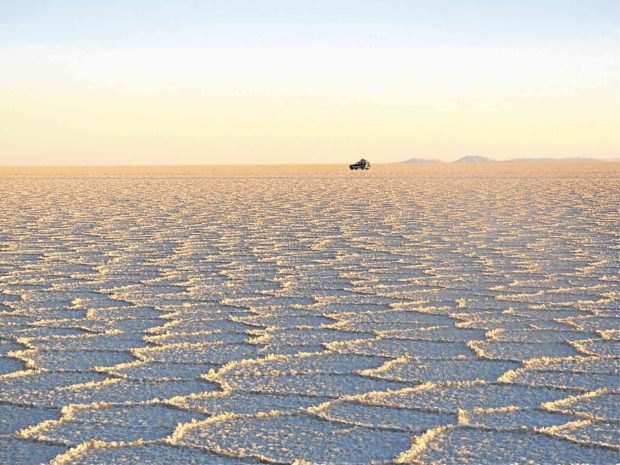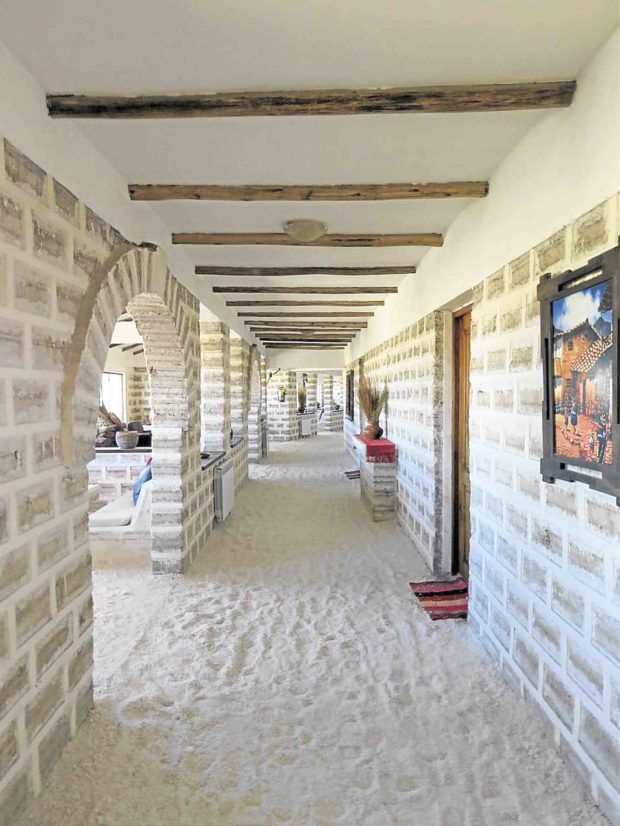
The Salar de Uyuni in Bolivia, a flat expanse of 11,000 sq km of salt, stretching out as far your eyes can see. Ten meters thick in some areas!
The white landscape was not apparent as we flew above the Andes mountain range in South America.
There I was, with my three female adventure travel companions, heading far up north, nearly grazing the insanely high mountaintops to spend two days visiting a white wonder. We came from the Argentinian capital of Buenos Aires and flew into La Paz, Bolivia, before taking a tiny plane to Uyuni on the Altiplano plateau of the Andes to experience its great salt flat, the Salar de Uyuni.
While there are other salt flats in the United States, Chile and Namibia, the Bolivian salt flat is by far the largest and one of the highest in the world.
This 11,000-square kilometer expanse of salt rests some 3,600 meters above sea level. It was once a prehistoric lake that eventually dried out, leaving behind a thick layer of salt and a few “islands” of rock, fossil and giant cacti. This salar is so incredibly flat that the National Aeronautics and Space Administration (Nasa) uses it to calibrate its satellite equipment. The most extreme height variance in its elevation is shockingly only all of 1 meter.
At the edge of all the salt is the little town of Colchani where our hotel was situated.
Colchani is a salt harvesting town, and our hotel was one of the handful of lodging places that sit on the shores overlooking the salar. While the salar is a bright white, its surrounding areas are grey desert sand and soil in a sad and mousy brown, dotted with cacti, rocks and the occasional llama or alpaca.
Our hotel, the two-storey Hotel de Sal Luna Salada, is built on one of these rocky fringes overlooking the expanse that stretches out to the horizon.

Bright hallways with diffused lighting are characteristic of all elongated spaces in this hotel. Fine pebbled salt floors too!
At the hotel’s entrance driveway, an assortment of totems and cacti welcome the guests into this rustic lodge. Upon entering, a large lounge area wraps around the front desk, and from here, a series of small group lounge areas that face out to views of the salar, line the long hallway that leads into the restaurant and to the staircase that takes guests up to the rooms. The hotel also has a small bar lounge, a billiards and darts area, a library, and even more lounge spaces along the second floor hallways that run along the length of the guest rooms.
Its boutique scale, with only 49 rooms and suites, boasts one of the better restaurants in the Uyuni area, with local fare and exotic drinks, including tea brewed from the popular coca leaves which the locals use to alleviate symptoms of altitude sickness.
Taking full advantage of its geographical context, the walls of Hotel de Sal Luna Salada are built up from blocks of salt quarried from the ground. At some areas in the salar, the salt can be as much as 10 meters thick. That’s the height of a three-storey structure.
The building blocks are more elongated than your traditional hollow blocks and actually resemble loaves in their proportions. They have natural color variances due to sedimentation, which creates a play of hues and tones—creams, caramels and beiges—giving texture and character to the walls. Even built-in furniture like stools, benches and lounges, are all made from these blocks.
Whereas the hotel room floors were in timber, most of the public spaces had pebbled flooring. But they were salt pebbles instead of stone. I liken the experience to walking through the crushed coral shores of a white sand beach, with the same creamy color palette, and the sensation of looseness underfoot which made it a tad bit difficult to walk and also demanded that you carried, rather than rolled, your hand luggage.
Large windows in the ground floor lounge areas faced out to views of the salar, taking a lot of the sunlight in, the diffused light inside creating even more softness to the bright, cream palette of the interior. While many of these surfaces are hard material, a generous amount of upholstery and pillows softened up the spaces.
Salt everywhere! At the lounge areas of the Hotel de Sal Luna Salada, walls, sofas and tables are constructed from blocks of salt. Even the floor is of crushed salt.
In true South American fashion, the furnishing fabrics were either a burst of bright and happy colors or deep neutrals like blues and khakis.
The fabrics were mostly the traditional hand-woven Bolivian bayeta which is made from llama or alpaca wool, its yarns dyed in natural pigment before being handloomed. Quite prominent were the jatan aku weaves, with wide and colorful striped patterns that are distinctive of the fabrics woven in this region of the Andean plateau. Timber and wicker are both used for furniture, and were in a palette ranging from dark tones to natural caramels and honeys.
The ceilings had exposed timber rafters that gave the spaces a warm and rustic look. From the high ceilings, black metalwork pendant lamps, lanterns and chandeliers hung, adding warmth and texture to the whiteness of spaces overhead. Local pottery, basketry, reeds and naturally distressed woodwork served as decor.
Long built-in sofas and many hammocks hung around the lounge spaces in both the ground and second floors, instantly conveying the message that this was a place for rest and tranquility.
Outside, there was a long multilevel timber deck that hugged the rocky landscape. It had a smattering of outdoor furniture where one could enjoy the crisp cool air and the warm sunshine, while at night, you can look up to the sky and gaze at the constellation of bright stars as we did. This was also the best place to enjoy the changing colors that came with every sunrise and sunset.
Distressed rafters create texture and give depth to their high ceiling. This entrance lounge has walls and furniture made from blocks of salt. —Hotel de Sal Luna Salada
The Hotel Luna Salada is some 15 kilometers away from the main town of Uyuni, and given the distance, the altitude and its isolation, it just made sense to build the structure from what was readily available and abundant—the salt.
It’s much like how our ancestors back home dug the ground for local volcanic tuff, adobe, and used that to build. Today we still find so many adobe structures standing. In the case of the salar, it would be interesting to see what else they would build with all that salt, in the years to come.

